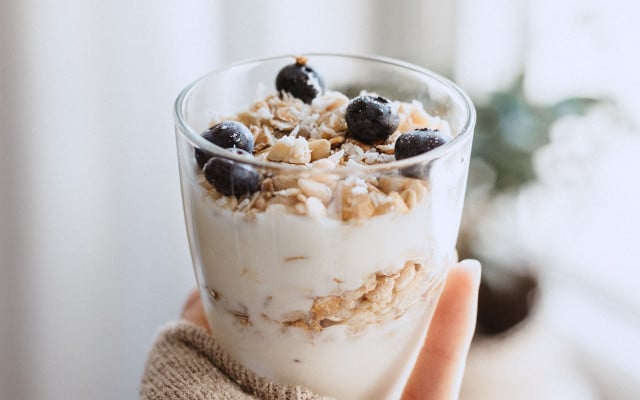With this tasty homemade yogurt recipe, you’ll know exactly what ingredients go into your yogurt. Making homemade yogurt is easier than you might think. We’ll show you.
Yogurt from the supermarket often contains a good deal of sugar and artificial flavoring or other additives. When it comes to homemade yogurt, it’s up to you what goes in. Plus, homemade yogurt is a blast to make. Here’s a simple yogurt recipe.
Homemade Yogurt: The Ingredients

For this scrumptious homemade yogurt recipe, you’ll need the following ingredients:
- 4 1/4 cups of organic milk: Feel free to use either dairy or milk alternatives such as goat or soy milk. Keep in mind: the higher the fat content, the creamier your homemade yogurt will be.
- 2 tbsp. plain yogurt or yogurt powder. You can find yogurt powder at larger supermarket chains or online. Plain yogurt or yogurt powder is essential for your first homemade yogurt. The bacteria help thicken the milk. Come the second round of recipe prep; you can use your own homemade yogurt.
- a sterile jars and a kitchen thermometer
Also interesting: Soy Milk vs. Almond: The Main Differences
How To Make Homemade Yogurt
- Heat the milk to about 90°F and let it simmer for about five minutes. This kills any bacteria present in the milk.
- Let the milk cool down to around 120°F. A kitchen thermometer may be helpful here.
- Now comes the “inoculation”: For every 4 1/4 cups of milk, you will need about two tablespoons of fresh, natural yogurt or yogurt powder (according to the packaging instructions). Now mix these thoroughly with the milk.
- Pour the mixture into the sterile jars, seal them and ensure that the temperature remains constant at around 120°F for the next twelve hours. Place the jars on a baking tray and leave them in the oven at 120°F. However, you should be sure to turn the oven off and on at regular intervals to prevent it from getting too hot. If the yogurt is heated to temperatures warmer than 120°F, the useful bacteria will die.
- Turn off the stove and leave the yogurt glasses in overnight to mature.
- Once you’ve reached the desired consistency, you can put the finished glasses in the refrigerator. You then have three to four days to enjoy your homemade yogurt or use it in another dish — say with fresh or dried fruit, nuts or fresh honey from your local beekeeper.
- If your homemade yogurt comes out a winner, remember to put 5 oz. of your yogurt aside so you can start the next one soon. After about seven “runs”, however, you will need fresh, natural plain yogurt or powder again, as the number of bacteria is reduced each time you prepare a batch.
Enjoy!
Make More at Home, Waste Less



Make your own homemade yogurt, and you’ll see how easy it is to go plastic-free. It’s one thing to practice plastic-free shopping, however, some items are simply hard to find not wrapped or housed in plastic. Take one step closer to a life without plastic with your homemade recipe addition to a happy and healthy morning routine (best served with fresh organic fruit, banana chips or whole grain cereal!).
** Links to retailers marked with ** or underlined orange are partially partner links: If you buy here, you actively support Utopia.org, because we will receive a small part of the sales proceeds. More info.Do you like this post?






